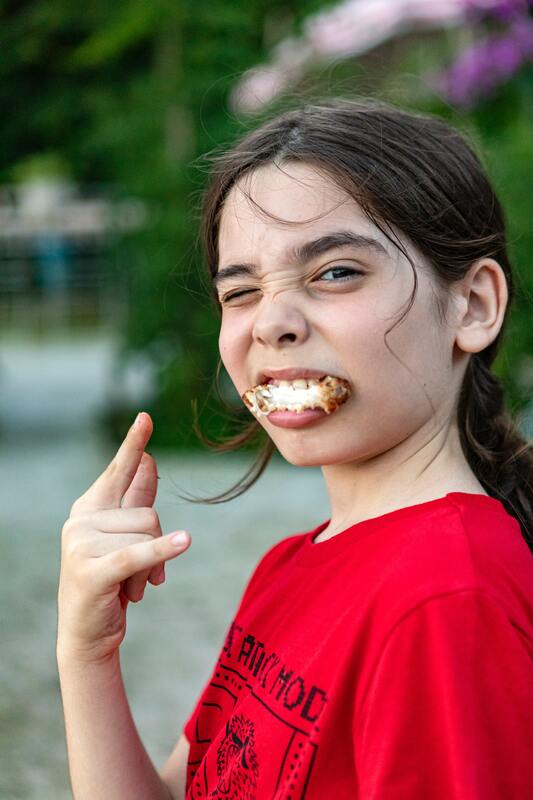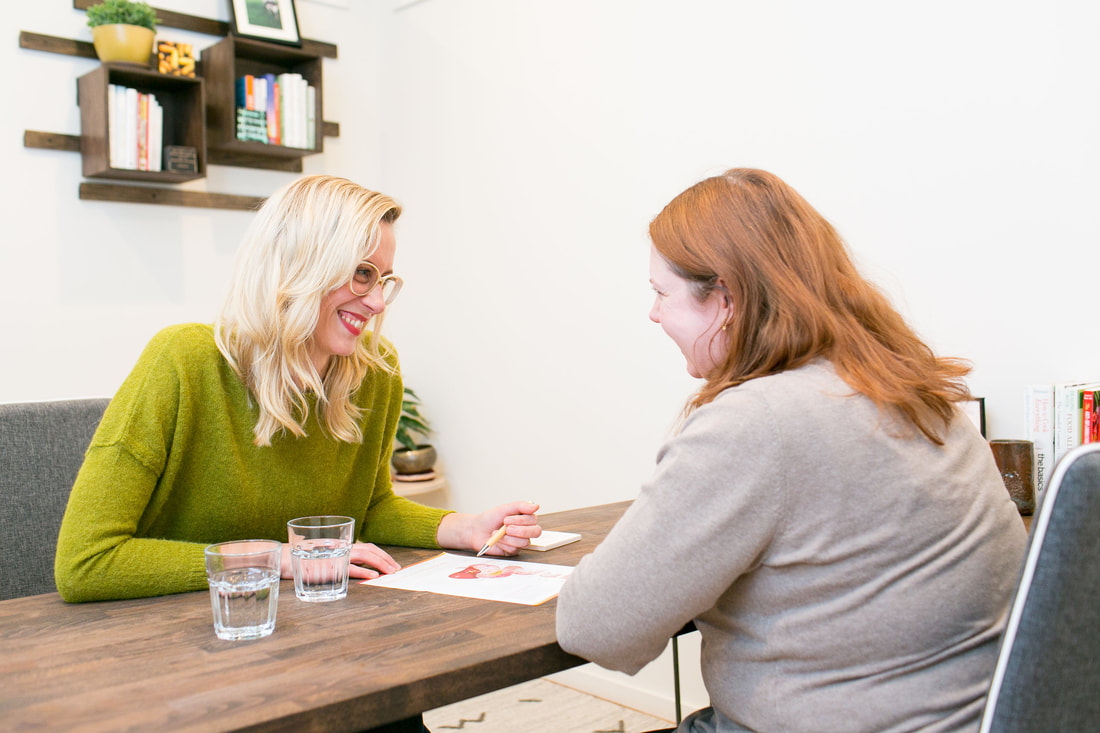|
What we know about nutrition changes every day. This is one of the things that makes being a nutritionist so fun and exciting - there's always something new to learn!
As an eater, who strives to do right by your body, this may also pose a challenge. It's tempting to eat the same thing day after day once you've dialed in what works for you. You find a formula that satisfies your appetite, is balanced, nutritious and doable. Why not rinse and repeat, right? It turns out that variety is not just the spice of life, it also imparts benefits to the body. Why? It's all about color! Phytonutrients are found in all plants. They are the pigments that give plants color, including anthocyanidins (blue, purple, black) and carotenoids (orange, red, yellow). They have potent antioxidant potential, helping to relieve oxidative stress that can lead to inflammation and disease. Interestingly, phytonutrients are also slightly toxic. This is actually beneficial to eaters because they gently guide and train the immune system, making it stronger and more resilient to infections and disease. Interesting stuff! The microbiome of the large intestine plays an intimate role in metabolizing phytonutrients. These chemicals are not broken down efficiently in the upper digestive tract where most nutrients are digested and absorbed. Instead phytonutrients make their way to the colon and are activated by the microorganisms there. Phytonutrients influence the microbes, encouraging a healthy immune response and reducing inflammation. In turn, the microbes transform phytonutrients into phenolic compounds that can be absorbed and used by the host/eater. It is largely accepted as truth that eating vegetables and fruits is an important feature of a healthy diet. Every client I talk to knows that the one thing they can do to improve their diet is to eat more from these food categories. That being the case, Americans tend to struggle with this dietary adaptation. Only 9% of Americans meet the USDA's recommendation of daily vegetable intake and 12% meet that for fruit. Affordable access to fruits and vegetables is a major concern in the wellness sphere. Additionally, preparation and storage of fresh produce is a barrier for many people. These concerns are beyond the scope of this article but worth mentioning as a contributing factor to the low consumption of fruits and vegetables in the US. In my experience and opinion, it's not an issue of educating the public on the health benefits of these foods, but an issue of equity. Insufficient vegetable and fruit intake has a detrimental impact on vitamin and mineral status, but there's more to plant-based foods than that. As researchers further our understanding of the role phytonutrients play in human health, a phytonutrient gap becomes apparent. One recommendation I make often to my nutrition clients is to eat the rainbow in plants every day. Getting in the habit of grabbing a red, orange, yellow, green, blue and purple item from the produce department is a great start to a meal plan that powers disease prevention and wellness. Phytonutrients are present in all plants. In addition to vegetables and fruits, nuts, seeds, grains, legumes, herbs and spices contain these compounds. Getting in the habit of making colorful, flavorful and beautiful food is a way to increase the phytonutrient density of your meals...while also giving your eyes a feast as well! If food preparation and cooking is a barrier for you working this habit into your life schedule, here are a couple tips to make eating the rainbow more manageable:
If you enjoy cooking with a recipe, here are a couple plant-heavy food blogs and cookbooks I recommend for getting inspired and making something delicious to enjoy:
Eating the rainbow can be a really fun self-care strategy that brings pleasure to all your senses and wellness to every system in your body. Bring on the color!
0 Comments
Stress and the desire to eat have a complex and interesting relationship. Some people have strong cravings and an increased appetite under stress, while others lose their appetite and motivation to eat when stressed. What makes one person eat and another not eat under stress is not clearcut, but many chemicals in the body play a role.
Hormones produced and secreted in response to psychological stressors influence appetite and the drive to satiate that hunger. Epinephrine and corticotropin releasing hormone (CRH) are hormones that are released from the adrenals and hypothalamus (respectively) when we first encounter a stressor. They have an inhibitory effect on appetite (in other words, they suppress appetite). The role of these two hormones is to fuel up muscles so we can fight or flee from the (presumably life threatening) stressor. So this inhibitory effect makes sense: your body doesn't want you to pause for a snack when you should be running from the bear. (Smart body!) In an ideal world, the stressor gets handled and removed. You process the stress and your body/mind/heart returns to a balanced state (aka eustress) and you go about your business. Your appetite returns to normal, signaling appropriate times to eat and not eat. Now, if that stressor is persistent, a second wave of hormones is secreted. This time it's our buddy cortisol (released by the adrenal glands). In periods of prolonged stress, cortisol does the opposite of its first-wave compatriots - it increases appetite. Cortisol also is a hormonal motivator, so not only is your appetite stronger but your desire to eat is also increased with chronic stress. This shift is presumably protective, because no one can put up a good fight or run any distance at full speed for long without refueling. These three "stress hormones" are really important players in the adaptive nature of our stress response. They have historically done a really great job at keeping us alive in the face of imminent perils. (Thanks, guys!) When we put ourselves in a modern day example - say a global pandemic - many of us are likely experiencing persistent stress, living in a cortisol bath that drives us to the pantry to soothe our worries day after day. In terms of the relationship between stress and appetite (and the drive to satisfy it with chips and guac), there's more at play. Ghrelin is often talked about a the "hunger hormone" because when secreted by the stomach it tells the brain to find something to eat. Ghrelin also plays a role in taste perception, reward behavior and reward recognition, among other things. It also has an anti-depressant effect, which may help balance out the emotional strain of stressful experiences. Epinephrine triggers the release of ghrelin as part of that first wave response to a stressor. Again, this is a highly adaptive response that gave our ancestors the drive to refuel after they got away from the bear. For us modern day folk, who are experiencing more psychological stress than life-threatening stress (the body can't tell the difference so the hormonal response is the same), our primary response is constantly being triggered. Epinephrine goes up in response to being stuck in traffic/dealing with an argumentative co-worker/navigating a distance-learning school year with your kid(s) while working from home...and ghrelin responds in full. Dopamine has two big effects on the body in regards to stress eating. It makes us feel both rewarded (I did a thing!) and connected (My heart is soothed because I did the thing!). Even thinking about food stimulates dopamine's release in the brain, an effect that is further amplified by eating a tasty treat. The bigger the "reward" the bigger the dopamine bath, so you get bonus points for cupcakes and popcorn. Here's another cool/not cool thing about dopamine: it's adaptive. So one cupcake today is going to stimulate a dollop of dopamine that you'll need two cupcakes tomorrow to obtain. To wrap this biology lesson up and put a bow on it, here's a summary of everything above: When you encounter a stressor, whether it be life-threatening or not, it stimulates hormones that have a snowball effect that results in an increased appetite and motivation to eat. Eating relieves stress by inducing an anti-depressant effect on your body, making you feel accomplished and connected. At this point you might be thinking, "but my friend/kid/partner has the opposite experience when stressed. They lose their appetite and motivation to eat!" Everyone responds to stressors differently. Some people find it easier to return to eustress than others. Some people experience acute stressors over and over and over, but stay out of chronic stress. Some people live in chronic stress for prolonged periods of time. Additionally, dopamine receptors are more sensitive in some individuals than others, making the reward-seeking behavior (like emotional eating) more powerful. To quote my current fan-girl obsession, Emily Nagoski, PhD "we're all made of the same parts, just arranged differently." This is what makes us interesting and unique, and what makes personalized medicine and nutrition such important tools for understanding ourselves and caring for ourselves in loving and authentic ways. Understanding the mechanisms that drive behavior help me understand myself better. I hope you find the same to be true and that this article gives you some objectivity for a topic that is often loaded with self-judgment. Here's the truth: you are not bad/weak/a failure because you stress eat (or don't). Instead, you are sensitive to a chemical storm inside you that rages every time your stress response is activated. You may be tempted to go on a diet or blame your eating habits for this. But if you are looking for the root cause of stress or emotional eating, it is the difficulty of returning to eustress. Developing your stress resilience is the key to changing that pattern. Without that, your body will seek out the easiest form of relief: more food. There are several self-care practices you can use to get out of acute and chronic stress to return to eustress more effectively. Emily Nagoski, PhD and Amelia Nagoski, DMA write about this and ways to "complete the stress cycle" in their book Burnout, which Dr. Barrett and I recommend to our patients often. Read it! In the meantime, come back to this article as often as you need to to get some emotional distance from what you are experiencing. Use this information as a mindfulness bell to practice non-judgment. That awareness will serve you when you are looking for relief in food and give you the perspective of knowing yourself better so you can care for yourself better. Resources and Recommended Reading: How stress can make us overeat. Harvard Health Chuang, Jen-Chieh, Zigman, Jeffrey M. (2010). Ghrelin's Roles in Stress, Mood and Anxiety Regulation. Hindawi. I am a summer LOVER. I love the sun, the heat, the iced coffees, the garden time, the hiking, the grilled food...I love SUMMER!
My immense enthusiasm for the season is often felt in my body, mind and heart as social burnout by mid-August. Every spring, I try to prepare myself for a full social calendar by making some boundaries for myself on how I'll spend my time and energy. Inevitably, I break all the rules and just give myself over to my love affair with summer. Here's something I've learned about myself during the pandemic: I don't actually have the same capacity as I had in the "before times." The constant stress of the past several years has diminished my - and many others' - capacity to engage, be active, socialize and be otherwise productive in everyday life activities. I personally recognize a greater need for alone time, rest, and sleep...and let me tell you: that does NOT align with my past summer-loving vibe! If you, like me, tend to overdo it in the summer and/or have noticed a change in your capacity, I'm offering up the following self-inventory reflection prompts to start honing in on your unique and seasonal self-care needs before the momentum of summer sweeps you off your feet. Before diving into any practice that aims at a deeper self-knowing, take some time to get embodied. Reflecting or journaling is a great activity to follow physical movement. This could be a full-blown workout or just a short walk or stretch session. Focus on feeling your body by taking deep breaths and not distracting yourself with conversation or other stimulus. Tuck in with a journal and a favorite pen, or a trusted friend to dialogue on the the following questions:
Let me use myself as an example for how I would use these prompts to create a personalized seasonal self-care plan. I know that I care best for myself when I have time to focus on myself and rest. I need a big chunk of time to "play" (i.e. do whatever I want). When I have that, I experience much less friction in my other health habits (eating, exercise, sleep, etc.). So, here's how I can line that up for myself this summer:
That might sound really, really simple...but the easier the approach to a new habit works the best for me. I know that not only can I sustain something that feels easy, I also want to! I hope this inventory helps you engage with some inner wisdom and shores up some self-care habits that serve you through this summer and beyond. I recently saw my 500th nutrition client, which was such a sweet mile marker to reach in my practice.
In the past week, though, I also had four separate conversations that included the question, "so what does a nutritionist do, anyway?" It made me pause - and laugh - and realize this article was long overdue! You see, the answer is not straight-forward. Sure I talk to people about what they eat. I tie that back to how they feel and help them find ways of using food to find better balance in their bodies. When talking with someone about their health challenges and goals, my mind is running metabolic pathways to hack the biochemistry (which is fueled by nutrients) that needs correcting to resolve the issues and help my client feel their best. I recommend food plans, share recipes, help put together menus and make supplement recommendations. If you looked up the job description for a nutrition professional, this is essentially what you would find. And this is also where my approach diverges from that definition, conventional nutrition therapy and even from functional medicine (I have education in both approaches). Here's the divergence: I know that food is deeply personal. It is more than just calories and nutrients. Food is ritual. It's tradition, religion, culture. Food is comfort; a foe and a friend. We are as likely to choose food because of its cost, convenience and accessibility as we are to choose food because it's "good" for us, and our food choices also reflect our political, ethical and moral values. We have a lot of thoughts, beliefs and feelings about what our food choices say about us. Our self-image is wrapped up in what is on our plate and there's often a running tape of all the things we "should" and "should not" be eating. So, let me say it again: food is personal. We can't ignore that when using food to heal. Instead, it lays the foundation for my work with each client. Together, we explore the ways that relationship with food and their body. I integrate mind-body medicine into each treatment plan to build self-care tools in mindfulness and self-compassion that my clients take with them into holidays, birthdays, vacations and times of high stress. We work on cultivating and nurturing change from within with one delicious meal at a time. I don't ignore all that nerdy biochemistry that I love, but bring it alongside an examination of habits, imbedded messages, cultural traditions, food access, self-talk and other influencers that make sneaky contributions to dysfunction and disease. This is what makes my job so fun! I love putting the pieces together for my clients and holding space for them to experience their health and relationship with food and their body differently. Full truth: there are no quick fixes in this approach. No band-aides. No golden tickets. But in each of those 500 cases, there is movement. There is growth and change that leads to the kind of healing that is not only sustainable, but pleasurable. I welcome you into that space with me whenever you're ready. |
I love food.I love thinking about it, talking about it, writing about it. I love growing food, cooking and eating food. I use this space to try to convey that. Follow me on social media for more day-to-day inspiration on these topics. Categories
All
|




 RSS Feed
RSS Feed